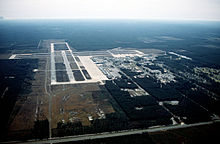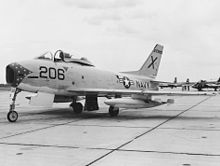- Naval Air Station Cecil Field
-
Coordinates: 30°13′07″N 081°52′36″W / 30.21861°N 81.87667°W
NAS Cecil Field IATA: NZC – ICAO: KVQQ – FAA LID: VQQ Summary Airport type Military: Naval Air Station Operator United States Navy Location Jacksonville, Florida In use 1941 - 1999 Elevation AMSL 81 ft / 25 m Runways Direction Length Surface ft m 9L/27R 8,002 2,439 Asphalt/Concrete 9R/27L 8,003 2,439 Asphalt/Concrete 18L/36R 12,504 3,811 Asphalt/Concrete 18R/36L 8,003 2,439 Asphalt/Concrete Source: Federal Aviation Administration[1] Naval Air Station Cecil Field or NAS Cecil Field (IATA: NZC, ICAO: KVQQ, FAA LID: VQQ) was a United States Navy base, located in Duval County, Florida. NAS Cecil Field was the largest military base in the Jacksonville, Florida, area.
NAS Cecil Field consisted of four separate facilities, the Cecil Field Complex (Cecil Field), the Outlying Field ("OLF") Whitehouse, the Yellow Water Weapons Department and the Pinecastle [Pine Castle] Electronic Warfare Target Area / Warfare Range. Including nearly 2,500 acres (10 km²) at OLF Whitehouse, the Cecil Field complex consisted of 22,939 acres (92.8 km²); in addition, the base leased another 8,379 acres (33.9 km²). Approximately 17,200 acres (69.6 km²) were transferred to the private sector, the remainder was transferred to Naval Air Station Jacksonville.
As directed by Congress in BRAC 1993 and BRAC 1995, the facility was decommissioned 30 September 1999.[2]
Contents
History
Cecil Field was named in honor of Commander Henry Barton Cecil. Shortly before World War II, a 2,600 acre (11 km²) tract of land was purchased in Duval County and construction began on the "U.S. Naval Auxiliary Air Station, Cecil Field."
1940s
The base got its start in June 1941, and operations were accelerated just 11 days after the Japanese Attack on Pearl Harbor.
VF and VSB units of Advanced Carrier Group, Atlantic arrived at Cecil Field in late 1942 to commence replacement pilot combat training.
Cecil Field was commissioned as a Naval Auxiliary Air Station (NAAS) in February 1943.
In March 1943, the fighter training unit moved to nearby Lee Field, in Green Cove Springs, and NAS Cecil Field became the principal war-at-sea and dive-bombing training center for the Navy. From 1943 until the war ended, Cecil Field was a pilot's last stop before assignment to combat in either the Atlantic or Pacific fleet. It operated at full capacity during the war years and after the war.
1950s
Disestablished at the end of World War II, it was then re-established and disestablished until finally designated as a Naval Air Station on June 30, 1952. The station was rejuvenated as an operating base for fleet aircraft units which ushered in the "jet age" for the Jacksonville area. In the mid-1950s Cecil Field's growth was given further impetus when the station was selected to serve as one of four bases specifically used for the operation of jet aircraft. In 1951 the land area of Cecil Field was increased to 4,600 acres (19 km²) and additional new buildings and facilities were constructed. Naval Air Station Cecil Field occupied 19,664 acres (79.6 km²), and was projected to be Navy's largest master jet base.
Aircraft
- RF-8 Crusader
- A-7 Corsair II
- F/A-18 Hornet
- S-3 Viking
- ES-3 Shadow
Commands
It was RF-8 Crusaders from VFP-62 out of Cecil Field who detected the presence of missiles and monitored the Soviet buildup during the Cuban Missile Crisis. Squadrons from NAS Cecil Field were aboard every Atlantic Fleet aircraft carrier deployed to Southeast Asia during the Vietnam War. During this period, 13 Cecil Field pilots were listed as POW or MIA. The POW/MIA memorial located behind the base chapel has become the chosen site for retiring AGs and METOC officers to hold their retirement ceremonies. The first Atlantic Fleet Squadrons to fly the A-7 Corsair II, the FA-18 Hornet, the S-3A and S-3B Viking, and the ES-3 Shadow were all based at NAS Cecil Field. Cecil Field squadrons again made history during the Gulf War, marking the final combat deployment for the A-7E Corsair II and the first combat operations for the S-3B Viking. The first weather observations were recorded at Cecil Field in May 1949, with the first meteorological equipment installed in December of the same year. In those days, weather observing and forecasting services were provided by the Meteorology Division of the Air Operations Department. The "weather guessers" of Cecil Field first became a detachment, as Naval Weather Service Environmental Detachment (NWSED), Cecil Field when, in an effort to centralize control of support from the Navy's shore-based meteorological units, the CNO established the Office of the Naval Weather Service on December 29, 1965. In September 1979, almost 14 years later, the name changed to Naval Oceanography Command Detachment (NOCD), Cecil Field.
Base Realignment and Closure
Naval Air Station Cecil Field was identified for closure by the federal Base Realignment and Closure Commission ("BRAC") and approved by the Congress and the President in July 1993. Upon this notice by the BRAC, the city of Jacksonville initiated the development of a reuse plan to guide transition of base property and facilities to other uses that support local goals for economic and community development. There have been efforts to see the base returned as a Naval Air Station (NAS), but these have failed due to political and economic forces.
References
- ^ FAA Airport Master Record for VQQ (Form 5010 PDF), retrieved 2007-03-15
- ^ GlobalSecurity.org - Naval Air Station Cecil Field. Retrieved 25 February 2007.
External links
- Cecil Commerce Center (official site)
- The Nuclear Weapons Storage Facility at Yellowwater
- FAA Airport Diagram (PDF), effective 20 October 2011
- Resources for this U.S. military airport:
- AirNav airport information for KVQQ
- ASN accident history for NZC
- NOAA/NWS latest weather observations
- SkyVector aeronautical chart for KVQQ
Categories:- United States naval air stations
- United States Navy bases
- Airports in Jacksonville, Florida
- Military in Jacksonville, Florida
- Military Superfund sites
- Military facilities in Florida
- Closed facilities of the United States Navy
Wikimedia Foundation. 2010.




